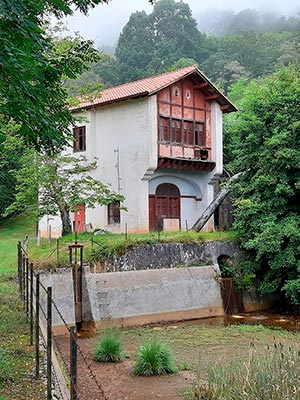Hydroelectric power plants in the Bidasoa basin
Ituren power stations
The hydroelectric complex formed by the Mendaur reservoir and the two power plants it feeds is located in the municipality of Ituren. The pressure pipe runs directly from the dam to a first power station, Ituren I - Armaurri, located at average hillside near the track leading up to the reservoir. The turbined water from this plant passes to a small drainage reservoir located in front of it, from where it is conducted to a loading chamber from where the pressure pipe leaves to the second plant, Ituren II - Aurtitz, located next to the Ezkurra river and visible from the NA-170 road (Doneztebe-Leitza), two hundred meters after the Aurtitz nucleus. Mendaur, one of the most popular destinations for hiking enthusiasts, offers easy access to the different elements that comprise the water conduction, such as the two kilometers of steel pipes that cross a drop of more than five hundred meters.
The Ituren waterfall came into operation in 1919 at the initiative of the Gipuzkoa-based business Cementos Rezola, which needed to increase energy production to meet the needs of its Añorga plant, on the outskirts of San Sebastian. The Ituren power was in addition to that provided by the Goizueta plant, commissioned by the cement company in 1911. The Ituren hydroelectric complex would remain in the hands of Rezola until 1935, when it was sold to Fuerzas Hidroeléctricas de Navarra (Fensa).
The central building located at average slope adopts the language of Basque regionalist architecture, with elements inspired by the popular architecture of the area. The second floor of the main façade is overhanging on a wooden cantilever and has four bay windows, wooden trusses and triangular ventilation openings or dovecotes under the eaves, all flanked by the traditional firebreaks on triple corbels. The second floor is framed by a large segmental arch. The color red dominates the wood and the mock brick of the facing. It is a small powerhouse that only houses a turbine and generator group .
The power plant located in the valley is larger, since it consists of two groups, and has a more industrial aesthetic. The area of the turbine conference room is illuminated by twin openings sheltered by a large segmental arch, a composition that is repeated on three occasions.
ALEGRÍA SUESCUN, D., "El molino harinero de Zubieta. Evolución histórica", in Notebooks of ethnology and ethnography of Navarren.º 82 (2007), pp. 5-15.
APEZTEGUÍA ELSO, M. and IRIGARAY SOTO, S., "El Ecomuseo del Molino de Zubieta (Navarra): experiencia pionera en la recuperación y musealización de una instalación preindustrial", in Museum: Magazine of the association Profesional de Museólogos de España (Professional Association of Museologists of Spain)No. 4 (1999), pp. 181-192.
BERAZALUCE ELCARTE, M., "La industria hidro-eléctrica en Navarra", in Rafael Guerra (ed.), Navarra. Ayer, hoy y mañana, Pamplona, Diputación Foral de Navarra, 1933.
HERREROS LOPETEGUI, S. (coord.), Centrales Hidroeléctricas en Navarra (1898-2018), Pamplona, Gobierno de Navarra, 2020.
Map of status based on El agua en Navarra, Pamplona, Caja de Ahorros de Navarra, 1991.











